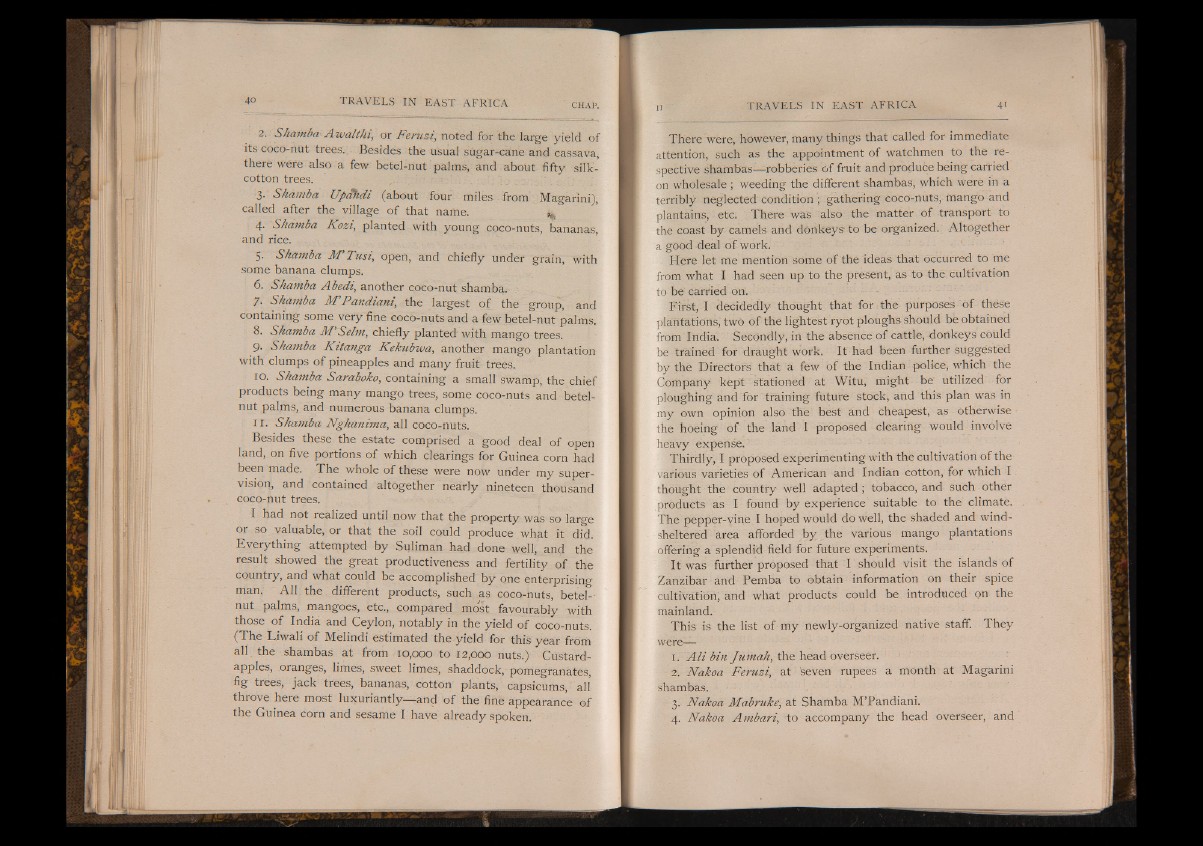
2. ShambaAw althi, or Ferazi, noted for the large yield of
its coco-nut trees., Besides the usual sugar-cane and cassava,
there were also a few betel-nut palms, and about fifty silk-
cotton trees.
3- Shamba Upakdi (about four miles from Magarini),
called after the village of that name. ^
4- Shamba Kozi, planted with young coco-nuts, bananas,
and rice.
5. Shamba M ’ Tusi, open, and chiefly under grain, with
some banana clumps.
6. Shamba A bedi, another coco-nut shamba. 7- Shamba M ’Pandiani, the largest of the group, and
containing some very fine coco-nuts and a few betel-nut palms.
8. Shamba M ’Selm, chiefly planted with mango trees.
g. Shamba Kitanga Kekubwa, another mango plantation
with clumps of pineapples and many fruit trees.
10. Shamba Saraboko, containing a small swamp, the chief
products being many mango trees, some coco-nuts and betel-
nut palms, and numerous banana clumps.
11. Shamba Nghanima, all coco-nuts.
Besides these the estate comprised a good deal of open
land, on five portions of which clearings for Guinea corn had
been made. The whole of these were now under my supervision,
and contained altogether nearly nineteen thousand
coco-nut trees.
I had not realized until now that the property was so large
or so valuable, or that the soil could produce what it did.
Everything attempted by Suliman had done well, and the
result showed the great productiveness and fertility of the
country,_and what could be accomplished by one enterprising
man. All the different products, such as coco-nuts, betel-
nut palms, mangoes, etc., compared most favourably with
those of India and Ceylon, notably in the yield of coco-nuts.
(The Liwali of Melindi estimated the yield for this year from
all the shambas at from 10,000 to 12,000 nuts.) Custard-
apples, oranges, limes, sweet limes, shaddock, pomegranates,
fig trees, jack trees, bananas, cotton plants, capsicums, all
throve here most luxuriantly— and of the fine appearance of
the Guinea corn and sesame I have already spoken.
There were, however, many things that called for immediate
attention, such as the appointment of watchmen to the respective
shambas—-robberies of fruit and produce being carried
on wholesale; weeding the different shambas, which were in a
terribly neglected condition ; gathering coco'-nuts, mango and
plantains, etc. There was also the matter of transport to
the coast by camels and donkeys' to be organized. Altogether
a good deal of work.
Here let me mention some of the ideas that occurred to me
from what I had seen up to the present, as to the cultivation
to be carried on.
First, I decidedly thought that for the purposes of these
plantations, two of the lightest ryot ploughs should be obtained
from India. Secondly, in the absence of cattle, donkeys could
be trained for draught work. It had been further suggested
by the Directors that a few of the Indian police, which the
Company kept stationed at Witu, might be utilized for
ploughing and for training future stock, and this plan was in
my own opinion also the best and cheapest, as otherwise
the hoeing of the land I proposed clearing would involve
heavy expense.
Thirdly, I proposed experimenting with the cultivation of the
various varieties of American and Indian cotton, for which I
thought the country well adapted; tobacco, and such other
products as I found by experience suitable to the climate.
The pepper-vine I hoped would do well, the shaded and wind-
sheltered area afforded by the various mango plantations
offering a splendid field for future experiments.
It was further proposed that I should visit the islands of
Zanzibar and Pemba to obtain information on their spice
cultivation, and what products could be introduced on the
mainland.
This is the list of my newly-organized native staff. They
were—-
1. A li bin Jumah, the head overseer.
2. Nakoa Feruzi, at seven rupees a month at Magarini
shambas.
3. Nakoa Mabruke, at Shamba M’Pandiani.
4. Nakoa Ambari, to accompany the head overseer, and